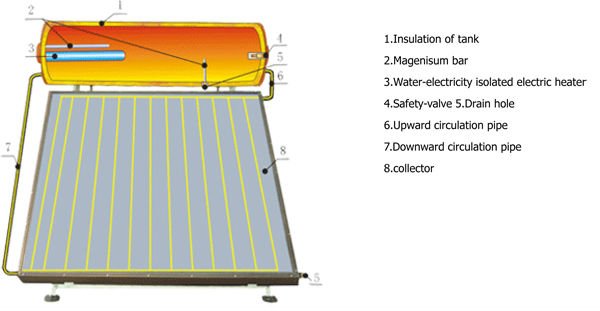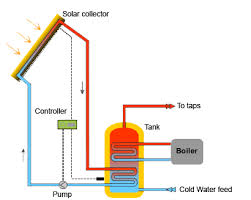1) Thermosiphon systems
It is one of the most basic and well designed solar water heater systems. This is a tremendous investment in saving energy for heating waters for all usage – an investment that will pay for itself several times over through the years that it works. The monobloc thermosyphon solar water heater is one of the least complex, most affordable and most cost effective investments for selecting a solar energy application product.
The water tank of a thermosyphon system itself usually does not require any pumps and controllers to operate in its simplest form – using the pressure of the water connection in house would allow the system to operate effectively as an on-demand hot water system, heating the water in the tank to well over 60 degrees (under fair conditions) before it enters house to be used.

2) Forced circulation systems
Forced heating systems are the ideal solution for producing large quantities of hot water: for buildings with numerous apartments, nursing homes and for places that have a very high consumption of water such as hotels, restaurants, sports centers or gyms with showers…
Forced circulation systems use electrical pumps, valves, sensors and controller to circulate water or other heat-transfer fluids through the collectors. This enables a high degree of flexibility in the positioning of the system components. For example, the tank can be installed in a basement. In addition the system can operate with a series of collectors to supply heated water to several large tanks, making it suitable for hotels, swimming pools and other commercial applications.

3) Drain back systems
Drainback systems are closed-loop, indirect, active systems. The water contained in an unpressurized, closed loop is pumped through the collectors and is separate from the end-use water being heated through a heat exchanger. When the pump is off, the heat-transfer fluid drains out of the properly sloped collectors and pipe, leaving them empty and protected from freezing.
The basic components of a drainback system are:
- – A storage tank.
- – One or more solar collectors.
- – A differential controller, which monitors the water temperature in the tank and the collector temperature. When the collector temperature exceeds the storage temperature by a set differential (number of degrees), the controller activates the pump.
Drainback systems have many advantages compared to other types of SHW systems. Because it needs an air space in order to drain, the loop is not pressurized. Less stress is placed on solder joints, threaded fittings, and gaskets. Furthermore, there are no motorized valves to fail, and the system does not rely on electricity to maintain freeze protection. If the power goes out, the pump shuts off and the water drains from the collectors back into the reservoir.

Drain Back Tanks are designed to allow the solar collectors to drain all water from the collector and related pipe connections into the drain back tank reservoir to protect the system from freezing and overheating. Drain back systems are a smart choice when designing a solar thermal system to supplement central heating and domestic hot water heating components. Maintenance is reduced when compared to a pressurized glycol system.
